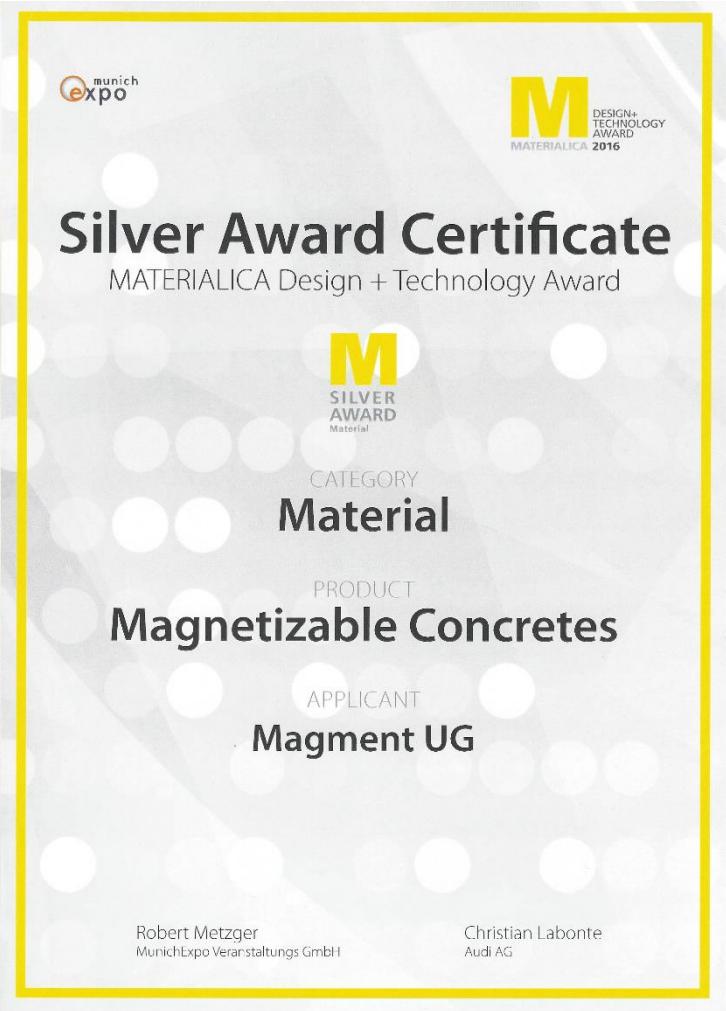Table of Contents
Magment
| Stan Zurek, Magment, Encyclopedia Magnetica, http://www.e-magnetica.pl/doku.php/magment |
Magment (Magnetic cement) - a trade name used by the company Magment UG for a type of composite magnetic material comprising magnetic particles embedded in cement (concrete) or asphalt.1)2) There is a wider class of materials which can be categorised as magnetisable concrete.
 Copyright © Magment UG
Copyright © Magment UG
| → → → Helpful page? Support us! → → → | PayPal | ← ← ← Help us with just $0.10 per month? Come on…  ← ← ← |
Internal structure and composition
 Copyright © Magment UG
Copyright © Magment UG
Magment is a composite material comprising two main fractions of magnetic particles. The larger fragments can be up to around 8 mm (like “gravel”) and the smaller around 2 mm (like “sand”). 3)4)
The magnetisable particles comprise up to 95% of weight, and provide appropriate magnetic properties. The cement (or asphalt) is a bonding agent.
The magnetic particles can be used from scrapped electronic parts, for example ferrite cores rejected during production or sorted electronic waste5). Ferrite material is especially useful because it provides: reasonable permeability, high corrosion resistance (it is already a form of oxide), high electrical resistivity, low hysteresis loss, good stability of properties versus time, and it is fairly inexpensive to obtain or produce various particle sizes.6)
According to the manufacturer, a suitable typical composition of the magnetic particles would be as follows:7)
Construction of magnetic components
The material is available from the manufacturer in a form of dry aggregate, pre-mixed with the specific ratio of magnetic particles and cement (similar to ready mixed concrete). Water must be added with a required ratio and mixed for instance in an ordinary cement mixer. The available processing time is around 30 min (before setting).8)
The inductive component is made first by designing the magnetic circuit. The windings (primary, secondary, etc.) can be wound first and placed in the appropriate form (mould) for casting. The wet concrete can the poured around the windings.
Sufficient density and quality of such magnetic concrete can be achieved without additional pressure or vibration.
The mould can be taken off after typically less than 1 hour and the concrete is strong enough to be walked on after 6 hours. Full strength is achieved after similar time as for ordinary concrete (28 days).9)
Applications
 Copyright © Magment UG
Copyright © Magment UG
According to the manufacturer, magment can be used for many applications, for example:
- EMC components
- stationary wireless power transmission for charging electric vehicles (buses, taxis, cars)
- dynamic “on-the-move” wireless power transmission (for moving cars)
Tests up to 30 kW stationary systems were demonstrated for wireless car charging.10)
Almost unlimited magnetic component size can be produced with the concrete-like processing.
Magment can be also used for making low-maintenance, hard-wearing surfaces (anti-vandalism).
Technical specification
| Technical specification of Magment MC4011) | ||
|---|---|---|
| parameter | conditions | value |
| initial permeability | at 25°C | typically 40 ±10% (up to 70) |
| Curie temperature | > 210°C | |
| resistivity | DC | 20 Ω·m |
| density | 3750 kg/m³ | |
| relative core loss | 50 kHz, 100 mT | 300 kW/m³ |
| specific heat | 700 J/(kg·K) | |
| thermal conductivity | 3 W/(m·K) | |
| Young's modulus | 25 000 MPa | |
| compressive strength | 20 MPa | |
| tensile strength | 2 MPa | |
 Copyright © Magment UG
Copyright © Magment UG
 Copyright © Magment UG
Copyright © Magment UG
 Copyright © Magment UG
Copyright © Magment UG
 Copyright © Magment UG
Copyright © Magment UG
Patents and awards
There are several patents related to the magnetic cement technology, for example:
In 2016 the company Magment UG won Silver Technology Award for “Magnetizable Concretes'' at the Materialica trade show.
Similarity to powder cores
Magment is a composite material, with certain amount of non-magnetic filling between the magnetic particles. Therefore, from a macroscopic viewpoint it behaves similarly to so called powder cores, whose permeability is a function of ratio of the magnetic content to the overall volume.
Effective magnetic permeability of such structure is significantly lower than that of the input magnetic material, because of the air gap between the particles.
The distributed air gap is capable of storing considerable amount of energy, which is why such materials are especially useful for power chokes and inductors typically used in high-power switch-mode converters and power supplies.
Because of the energy storage capability such materials are less useful for transformers. However, for devices with large physical dimensions such materials can still provide much better performance than the alternative solution - which would be normally some non-magnetic structure (like an ordinary concrete).
Therefore, with appropriate design magnetic shielding can be also achieved with such materials.
See also
External links
* http://magment.de - official website




